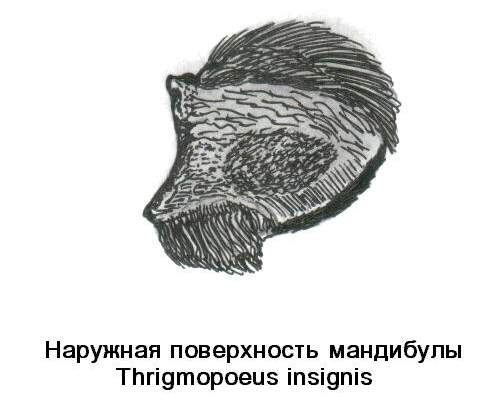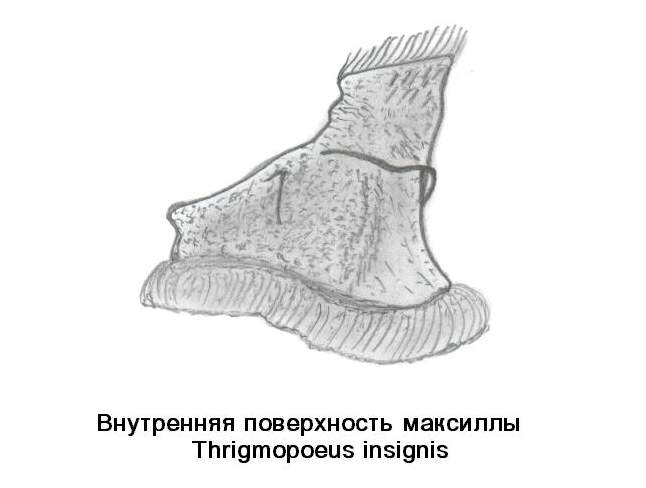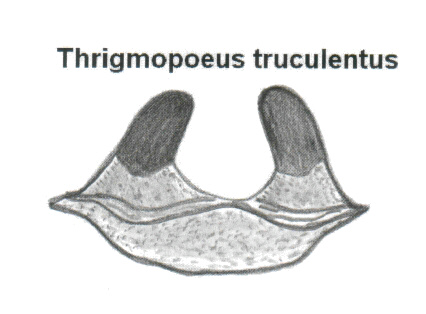Subfamily Thrigmopoeinae (Pocock, 1900)
Identification keys of tarantulas of subfamily Thrigmopoeinae
(By: B.K. Tikader. Handbook Indian spider. Zoological Survey of India, 1987, Calcutta) Representatives of the subfamily Thrigmopoeinae differs from other Theraphosidae by the following feature - outer surface of mandible not covered with scopula or pad of feathery hairs and as against the related subfamily Selenocosmiinae are characterized by presence of simple scattered, needle-like bristles at the inner surface of palpal coxa (maxilla).
The stridulating organ is located between the mandible and a basal segment of the palp (maxilla). On the mandible some of the hairs which form the posterior portion of the oral fringe are modified to form a small cluster of vibratile bristles (drawing 1) and on the adjacent surface of the maxillae there are regularly or irregularly arranged stiff aciculate bristles (drawing 2) which scrape against those on the mandible when the maxilla is moved up and down and emit a hissing.
Includes two genuses: Haploclastus and Thrigmopoeus. The systematization of this subfamily requires a revision. In particular, the tarantula Haploclastus kayi Gravely, 1915 is probably concerns to genus Thrigmopoeus (Rick West, information taken from R. West's site).
Distribution. As a whole all representatives of the subfamily Thrigmopoeinae occupy various (mainly tropical) landscapes of territory of the south and the west of India.
|
Key |
Features |
Genus name |
|
1 |
Stridulating bristles on maxilla irregularly scattered |
|
|
2 |
Stridulating bristles on maxilla arranged in a definite curved series, spermothecae (drawing 3) |
Genus Thrigmopoeus
1. Fovea as wide as ocular tubercle. Carapace longer than patella and tibia of leg II, equal to those of leg IV ......................Th. insignis
Total length 55 mm, length of carapace 27 mm, leg I - 76 mm, II - 68 mm, III - 56 mm, IV - 73 mm.
General colouration is blackish, hairs on carapace yellowish brown, darker on upper side of legs; velvety black on sternum, coxa and lower side of femora and abdomen. Leg I less than three times the length of the carapace, III a little more than twice the length. Patella and tibia of leg III as long as width of carapace.
Locality: Kanara Ghats (India).
2. Fovea less than width of tubercle. Carapace shorter than patella and tibia of leg II and than those of leg IV ......................Th. truculentus
Smaller and paler in color than the preceding species; carapace lower; fovea less than width of ocular tubercle; length of carapace less than that of patella and tibia and than protarsus and tarsus of leg IV. Legs longer, leg I nearly three and a half times as long as carapace.
Total length 40 mm, length of carapace 19 mm, leg I - 65 mm, II - 57 mm, III - 44 mm, IV - 62 mm.
Locality: Karwar (India).
Genus Haploclastus
1. Carapace low (or moderately elevated), fovea without depressing……........2
A. Leg IV as long as leg I and longer than leg II………...................………. H. cervinus
Total length about 30 mm; length of carapace 15 mm, width – 11 mm; length of of leg I – 39 mm, II – 27 mm, III – 31.2 mm, IV – 38.8 mm.
Integument blackish, hairs ferruginous. Carapace low. Legs moderately long, leg I scarcely longer than the leg IV.
locality: Palni Hills (South India).
This species is probably based upon a young specimen.
B. Leg IV shorter than I and II………………………………………….......H. nilgirinus
Total length 52 mm; carapace – 24 mm; leg I – 64 mm, II – 60 mm, III – 48 mm, IV – 58 mm.
Carapace black, clothed like the limbs and abdomen with brownish-yellow hairs. Sternum, coxa and lower side of femora at least of legs I and II velvety black. Carapace about one-fourth longer than wide, moderately high and convex; fovea large slightly procurved. Patella and tibia of leg II slightly longer than of leg IV.
Locality: Nilgiri Hills (Daly).
2. Fovea deep (with depressing), strongly procurved.
A. Femora of legs reddish, the rest of the segments greyish white (male) ……H. validus
Total length 25 mm, carapace 12.2 mm; leg I - 41 mm, IV – 46 mm.
Carapace with coating of silky yellow hairs, femora of legs with golden brown hairs, the rest of the segments with greyish white hairs. Abdomen covered above with long golden brown hairs. Carapace a little longer than broad, low and narrow in the head-region, shorter than patella and tibia of leg I and IV. Legs long and strong, with spines. Palps unspined, bulb of organ but little inflated.
Locality: Matheran (Phipson).
B. Legs uniformly colored…………………….................………………….H. robustus
Total length 27 mm, carapace 13 mm; leg I - 29 mm, IV – 33 mm.
Carapace and limbs reddish brown; abdomen blackish above; hairy clothing greyish red. Carapace long, head high, much longer than patella and tibia of leg I and IV. Legs short, very strong, spined.
Locality: Matheran (Phipson) and Jauli in Satara (Master).


